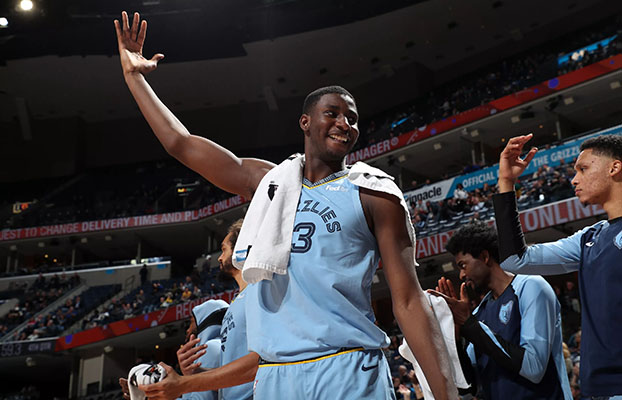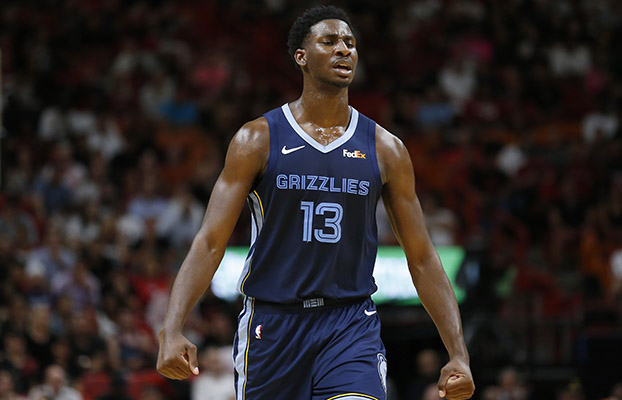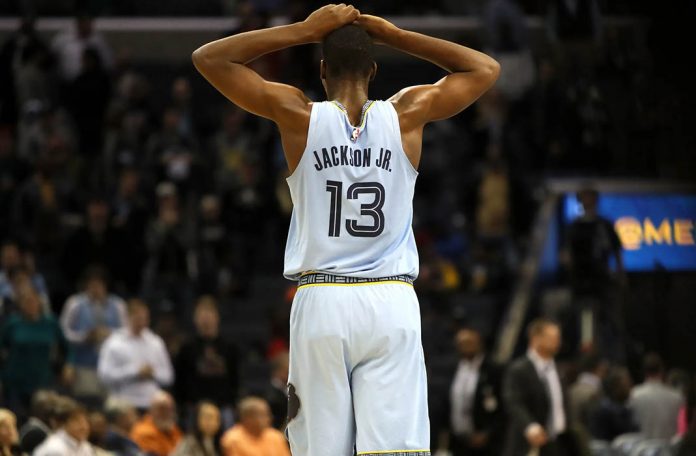The Memphis Grizzlies are a beautiful, confusing medley of old and new school basketball. There’s rookie sensation Ja Morant, a bundle of dynamite ready to go off at the slightest notice and a blast from the past with his pass-first instincts and shaky three-ball. The starting center is Jonas Valanciunas, a lumbering 7-footer who nobody can keep off the glass and is a machine down low.
In contrast, we have the less-heralded but nearly as valuable rookie in Brandon Clarke. He personifies the movement towards small-ball 4’s with his savvy defense and ultra-efficient finishing. An elite athlete who has expanded his range to the three-point line in the NBA, Clarke may end up being the steal of the draft.
Neither Morant or Clarke is the most intriguing player of the Grizzlies’ exceptional young core, however. We know what Morant projects to be a smarter John Wall who needs to fully weaponize his shooting. Similarly, Clarke can be a switchy 6’8″ defensive demon who’s automatic around the basket and occasionally makes a three or two. Both are likely going to be excellent players, but we’ve seen others of their ilk before.
The same can’t be said for Jaren Jackson Jr., however, one of those few basketball players that just make zero sense overall. There’s never been a player like Jackson before, and it’s anybody’s guess as to what he’ll be in the future. He might end up as the best defensive player of his generation, or perhaps he’ll go down as a disappointment due to his fouling woes. He could be an unstoppable shooter who’s unconsciously elite from deep, or maybe this is a fluke year. Simply put, Jaren Jackson Jr. is a basketball anomaly with a skillset the NBA’s never seen.
This season, Jackson is averaging 17.7 PPG, 4.7 REB, 1.4 AST, 0.7 STL, and 1.6 BLK on 47.9/40.5/74.5 shooting splits. Great counting stats for a 20-year-old, but nothing that screams extraordinary. So, why is his development so enthralling?

The fascination starts with his defense. There’s a very real possibility Jackson ends up being as good as Anthony Davis, a unicorn who flies around the court blocking everything in sight. Jackson is 6’11” with a 7’5″ wingspan; similarly proportioned to Davis’ 6’10” and 7’6″ arms. He’s slender like Davis, quick as a cat, and has a metronome’s timing with his hands. The most amazing part is his agility. Jackson is more mobile than many guards. He has the perfect body for the modern-day NBA defender, and more importantly, the IQ to boot. Defense is just natural for Jackson, a fact seen plainly in each swooping chase-down block or blind-side steal.
Admittedly, the advanced stats don’t like him right now. The Grizzlies allow 5.34 fewer points per 100 possessions when Jackson sits. He also has just 1.2 defensive win shares this year. For comparison, other notably elite defensive players like Ben Simmons are at 3.1. The metrics were kinder in his rookie season, projecting that Memphis was 4.16 points per 100 possessions better when Jackson was on the court, so it’s not like Jackson’s always been a dud on that end.
So, why does Jackson pass the eye test with flying colors but trip up in the defensive metrics? It’s clear what a precocious defender he already is just by watching. Why don’t the impact stats like him?
The easiest answer is fouling. Jackson fouls at a rate of 5.2 fouls per 36 minutes. It’s why he plays just 28 minutes a game despite his youth and offensive talent (we’ll get to that in a bit). Jackson’s lack of base strength and stability allow stronger players to bully him down low. He’s forced to foul unnecessarily, as he tries to regain his balance during these plays – a flail of wild arms. But, it’s not because Jackson’s uncoordinated, or that he’s beyond help. In fact, he often stops these bruising possessions prematurely by knocking the ball out before they can get a shot off. At just 20 years old, he simply hasn’t developed the strength to handle the physicality yet.
As a result, Jackson’s fouls restrain his game. He plays conservatively, afraid of the constant threat of the referee’s whistle. A lot of the calls are indeed questionable, but Jackson will learn what gets him whistled. A player can only do so much when they’re hesitant to commit physically to a play. But, there’s been plenty of elite defensive players who struggled with foul issues early in their careers. Draymond Green, for instance, was still fouling at a rate of 4.6 fouls per 36 minutes at age 23. Similarly, Metta World Peace committed 4.8 fouls per 36 minutes in his age-22 season. Both players ended up winning Defensive Players of the Year later. There’s hope for Jackson yet, and it’s a hill that others have climbed before.

Equally intriguing as Jackson’s defense is his offensive outlook. There’s something nonsensical to just how quickly he can get his shot off. There are 7-footers who are high volume three-point shooters like Karl Anthony-Towns and Brook Lopez, but their releases are slower. They don’t utilize their legs much, relying on the strength and control of their arms. It’s easier to shoot that way for a 7-footer, but it’s also slower without the quick momentum of the legs. Of course, it works for them because, at their height, only opposing bigs can seriously contest their shot.
Jackson isn’t like that. He shoots faster than most guards with a quick flick of the wrist, shooting on the way up unlike Lopez or Towns. He’s launching 6.5 threes a game this season and has made an incredible 40.6% of them. No player in NBA history 6’11” or above has attempted over 5 threes a game and made 40.0%. Jackson (and Karl Anthony-Towns) is on pace to achieve this groundbreaking feat this season.
Not to mention, Jackson is a fantastic lob target for the ever alley-oop hungry Morant. Anybody 6’11” with a 7’5″ wingspan would be, never mind one as quick and with as good of timing as Jackson. Jackson doesn’t need to learn how to be an elite shot creator to be effective as long as his point guard has a brain. In fact, if all Jackson did from now on was jack up threes and dunk the ball, he could still grow into a top 10 player in the future. There are only two or three players on each NBA team that can contest Jackson’s jumper at his absurd 9’2″ standing reach. He’s the perfect complementary weapon in any offense and will be the definition of an elite two-way player.
There’s never been a center in NBA history that was an elite stopper and elite shooter at the same time. Will Jackson lead a team to a championship? Probably not, unless he makes some unprecedented leap in ball-handling and post-ups. Will he give every opposing team fits as they try to guard him? Without question. Jackson’s shooting pulls every opposing center out to the perimeter. You want a spread offense? Jackson stretches the limits of spacing with his jumper and athleticism.
Years of evolution in “pace-and-space” have led to Jaren Jackson Jr, the 6’11” center-forward hybrid with top-notch defensive skills and mind-boggling accuracy from deep. This isn’t about whether or not Jackson can be a true superstar or win an MVP award. It’s an appreciation of just how rare a breed he is and his continually expanding ceiling. This is a guy you should be watching as much as possible over the next season. Jackson isn’t just breaking the mold, he’s smashing it – and you don’t want to miss it.
Instagram: @j_persources
Twitter: @j_persources

